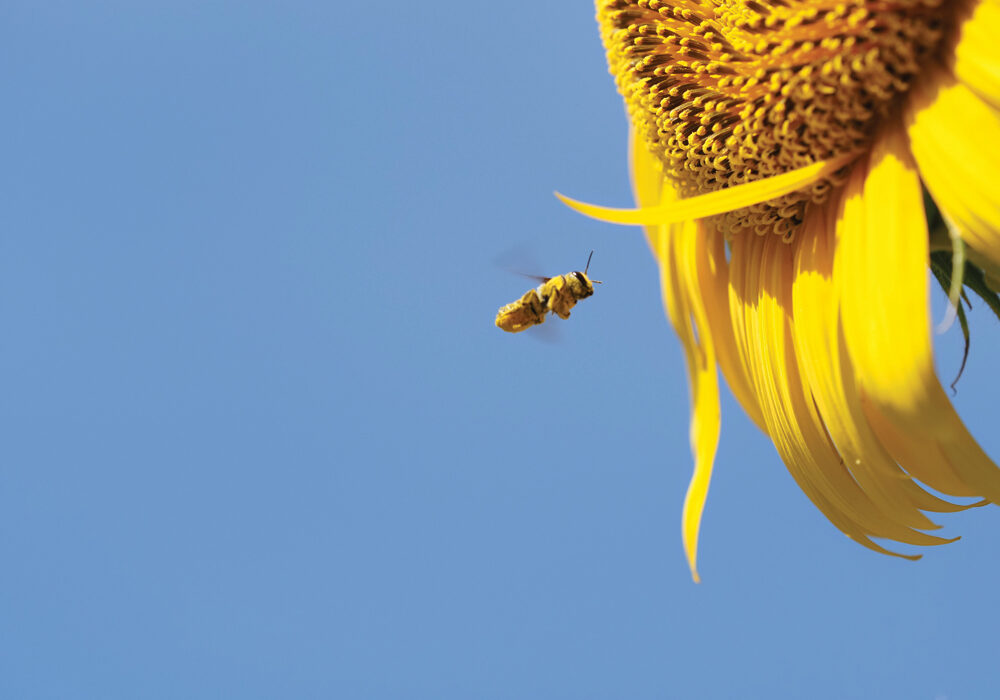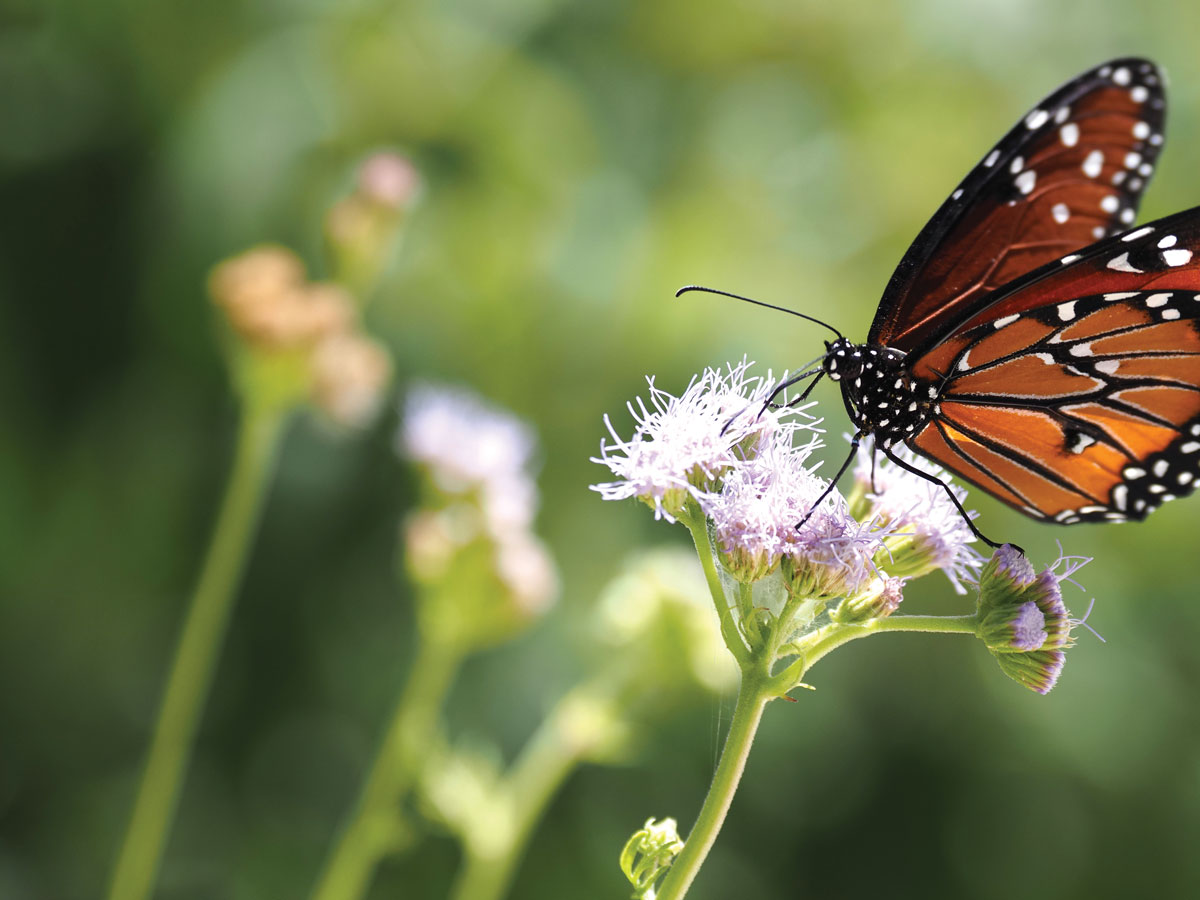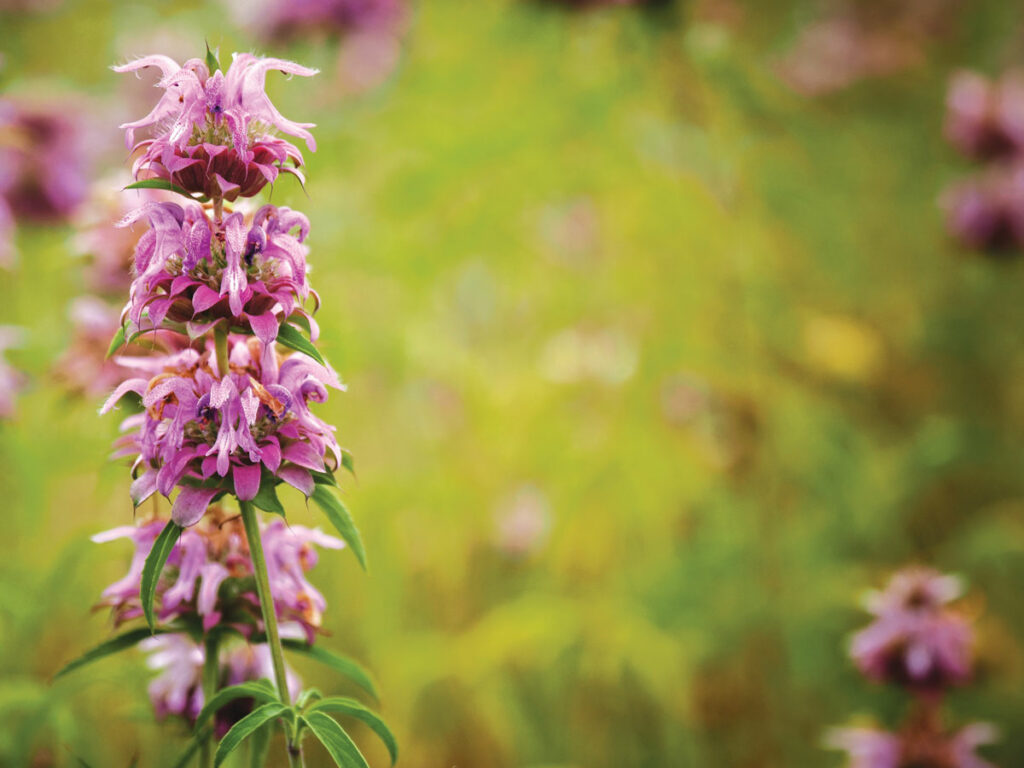
Sunflowers provide a source of nectar and seeds for pollinators. Birds love the seeds. Photo by Daniel Clifton
Without pollinators, we wouldn’t have food to eat, said Vicki Adcock, a member of the Highland Lakes Master Gardener Association. Close to 75 percent of the world’s crops depend on pollinators for sustained production, according to the United Nations Food and Agriculture Organization. That statistic doesn’t include the fruit trees and gardens in individual backyards around the world needing the help of bees, moths, flies, wasps, beetles, and butterflies to flourish, flower, and feed.
Habitat loss has created a giant void in pollinator plants, which is why Adcock and fellow Master Gardener Louise Suhey help manage The Church at Horseshoe Bay’s pollinator garden. Although the church’s plot is large, pollinator gardens come in all shapes and sizes.
“You can have a small space or even a few plants in pots,” Adcock said. “I think a key is making sure they’re native plants and some that bloom at different times of the year.”

A queen butterfly stops for nectar from a Bethany-leaf mistflower. Native flowers are the best plants for pollinators such as butterflies, bees, and hummingbirds, though each might prefer different plants. Staff photo by Daniel Clifton
Planting pollinator gardens is important for the future of all of the creatures that help cross-germinate plants while feeding on nectar. Some species require specific plants for laying their eggs, such as monarch butterflies, which plant their eggs on milkweed. In turn, the milkweed becomes the food source for the newly born larvae. In return for the nectar, pollinators help humans by pollinating plants in our food supply.
While some people avoid native plants, thinking they will curtail color in the garden, Suhey and Adcock disagree. They point to the church garden as a great example. Through a careful selection of plants that bloom at certain times of the year, the Remembrance Garden has more than a splash of color; it boasts a year-round wave.
Along with blooming times, Suhey and Adcock recommend selecting different bloom types since some pollinators prefer tubular flowers (hummingbirds), while others like a flat or open bloom (butterflies).
“I do encourage people to do their research,” Suhey said.
The Master Gardeners have a long list of plants native to the Highland Lakes that make good foundations for a pollinator garden in the area’s shallow and rocky soil.
“If someone asks what are the best plants to start with, I would say Gregg’s mistflower,” Adcock said. “It’s one of the best. Butterflies love it. It blooms all summer. You can cut it back, and it returns.”
Another one is the cowpen daisy. Monarch butterflies love it because it blooms late in the fall and doesn’t require a lot of water.
Suhey said she had more monarchs on her cowpen daisies this past year than any other plant.

While not as popular in pollinator gardens as other native plants, horsemint is a nice touch with its unique structure. Staff photo by Daniel Clifton
One of the most overlooked types of plants to establish for pollinators are bulbs. Suhey is a big fan of bulbs, something she fell in love with while living in San Antonio. She’s planted a number of daffodils as well as German irises, summer snowflakes, and Spanish bluebells.
Once they’re in the ground and established, the correct bulbs thrive in the Highland Lakes. Since the February freeze knocked so many native plants back a few weeks in the growing cycle, some of the only plants blooming in early March were bulbs, something the bees needed at that time, Suhey said.
Each plant has its own characteristics and attributes. Turk’s cap and cedar sage do well in shady spots, though the latter can be hard to find in nurseries or retail outlets. Prairie verbena transplants extremely well once it’s established.
“It’s easy to dig up,” Suhey said. “As long as you get the root ball, it will be alright.”
The passion flower has an incredible bloom, but deer like it. Suhey suggests planting agarita around passion flowers. The prickly agarita keeps the deer at bay and gives the flower a safe place to thrive.
Deer are among the biggest challenges to Hill Country gardening, both Suhey and Adcock said. Though deer might turn their noses up at some native plants, they don’t mind nibbling down others.
“I’m at the point now if deer don’t mess with it, it’s good for my garden,” Suhey said with a laugh.
“A lot of gardening is trial and error,” Adcock said. “You just have to try things.”
The Highland Lakes Master Gardeners at burnetcountyhighlandlakesmastergardener.org and the Highland Lakes Master Naturalists at txmn.org/highlandlakes are good sources for people interested in planting a pollinator garden. The Church at Horseshoe Bay’s Remembrance Garden labels all of its plants, serving as inspiration both biologically and spiritually.
Inks Dam National Fish Hatchery also has a pollinator garden. Another is being established at The King’s Garden in Kingsland. The Helping Center Garden Powered by Highland Lakes Master Gardeners at Trinity Episcopal Church in Marble Falls also put in pollinator plants. And at Inks Lake State Park, small pollinator gardens have been planted throughout.
Other resources worth checking out are the Lady Bird Johnson Wildflower Center’s website at wildflower.org, the Monarch Watch website at monarchwatch.org, and the Native Plant Society of Texas website at npsot.org/wp.
PERFECT POLLINATOR PLANTS
Master Gardeners Vicki Adcock and Louise Suhey recommend selecting different bloom types for pollinator gardens as some of nature’s cross-fertilizers prefer tubular flowers (hummingbirds), while others prefer flat or open blooms (butterflies). Here are just a few of the choices.
TUBULARS
- salvia greggii (autumn sage)
- cedar sage
- Jerusalem sage
- purple skullcap
- Esperanza
- Turk’s cap
FLATS
- Texas lantana
- fall aster
- prairie verbena
- purple coneflower
- common yarrow
- passion flower
- blackfoot daisy
- Mexican mint marigold
- bronze fennel
- dill












